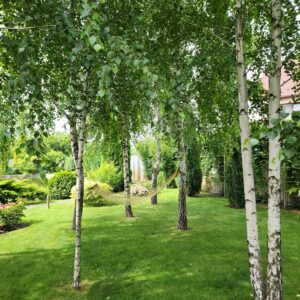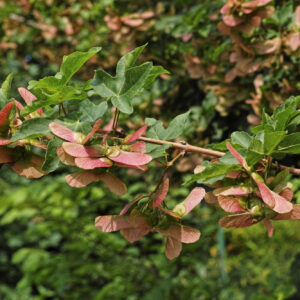Alnus glutinosa / Black Alder
Price range: £150.00 through £600.00
Frequently Bought Together




Description
Common Name: Common Alder, Black Alder, European Alder
Botanical Name: Alnus glutinosa
Family: Betulaceae
Origin: Native to UK, Europe, and Western Asia
Mature Height: 20-25 metres
Mature Spread: 8-12 metres
Growth Rate: Fast (60-90cm per year in ideal conditions)
Foliage: Deciduous; rounded, dark green leaves with a glossy finish, turning yellow-brown in autumn
Flowers/Catkins: Long, pendulous yellow-brown male catkins appear in late winter (February-March), followed by small woody female cones that persist through winter
Soil Requirements: Thrives in wet, waterlogged, or poorly drained soils; tolerates clay and compacted ground; pH adaptable
Light Requirements: Full sun to partial shade
Hardiness: Fully hardy (USDA Zone 3-7); tolerates exposed, windy sites and coastal conditions
Special Features: Nitrogen-fixing roots improve soil fertility; exceptional wildlife value; tolerates flooding and waterlogged conditions; native Irish species
Description
The Common Alder is our waterside companion – a tree that has shaped our riverbanks, bogs, and wetland margins for millennia. With its dark, fissured bark and rounded canopy, Alnus glutinosa creates a striking silhouette against winter skies, whilst in summer its glossy green foliage provides cool, dappled shade.
What makes the Alder truly remarkable is its relationship with the land. Through a symbiotic partnership with nitrogen-fixing bacteria in its roots, this tree actively enriches the soil around it, making it an invaluable pioneer species for challenging sites. Its roots stabilise riverbanks and prevent erosion, whilst its fallen leaves decompose rapidly, feeding the ecosystem below.
In late winter, before most trees have stirred from dormancy, the Alder announces spring’s approach with cascades of golden catkins that sway in the breeze. These are followed by small, woody cones that remain decorative throughout the year, providing food for siskins, redpolls, and other seed-eating birds.
The Common Alder is a haven for wildlife. Its branches shelter nesting birds, its leaves feed numerous moth caterpillars, and its roots create underwater refuges for fish and invertebrates. In the garden, it’s perfect for wet areas, pond edges, wildlife gardens, or anywhere you want to create a naturalistic, ecologically rich landscape.
This is a tree for those who garden with nature – a living link to Ireland’s wild places that brings structure, beauty, and biodiversity to even the most challenging sites.
Caragh Garden Notebook: Caring for Your Alnus glutinosa
Planting Your Common Alder
Choose a location with consistently moist or wet soil – the Alder positively thrives where other trees struggle. Pond margins, stream banks, boggy areas, or heavy clay soils are ideal. Whilst it prefers full sun, it will tolerate partial shade, particularly in its early years.
Dig a planting hole twice the width of the root ball but no deeper. The top of the root ball should sit level with the surrounding soil. Backfill with the excavated soil (no need for amendments – the Alder will improve the soil itself), firm gently, and water thoroughly. Mulch around the base with organic matter, keeping it clear of the trunk.
Plant from November to March for bare-root or root-balled specimens, or year-round for container-grown trees (though autumn and spring are still preferable).
Watering & Feeding
Water regularly during the first growing season to establish a deep root system. Once established, the Common Alder requires no supplemental watering – it’s adapted to find moisture even in saturated ground.
Feeding is unnecessary. The Alder’s nitrogen-fixing roots mean it essentially feeds itself whilst improving the soil for neighbouring plants.
Pruning & Maintenance
The Common Alder requires minimal pruning. Remove any dead, damaged, or crossing branches in late summer to early autumn (August-October) when the tree is less likely to bleed sap. Avoid heavy pruning in late winter and spring.
Young trees may benefit from formative pruning to establish a strong central leader and well-spaced branches. Mature specimens are best left to develop their natural form.
Seasonal Interest
Winter: Architectural bare branches adorned with persistent woody cones; male catkins begin to elongate and show colour from January onwards.
Spring: Spectacular display of long, pendulous yellow catkins in February-March; fresh green leaves unfurl in April.
Summer: Dense, glossy green canopy provides cooling shade; small green female cones develop.
Autumn: Leaves turn yellow-brown before falling; woody cones mature to dark brown and persist through winter.
Companion Planting
The Common Alder’s ability to fix nitrogen makes it an excellent companion for other moisture-loving plants. Underplant with native wildflowers such as Primula vulgaris (Primrose), Hyacinthoides non-scripta (Bluebell), or Ajuga reptans (Bugle). For a layered woodland effect, combine with Corylus avellana (Hazel), Salix caprea (Goat Willow), or Betula pendula (Silver Birch).
At the water’s edge, pair with Iris pseudacorus (Yellow Flag Iris), Filipendula ulmaria (Meadowsweet), or Caltha palustris (Marsh Marigold) for a naturalistic wetland planting.
Design Suggestions
• Wildlife Gardens: Plant as a specimen or in small groups to create habitat for birds, insects, and aquatic life
• Wetland & Bog Gardens: Ideal for naturalising in damp areas where other trees struggle
• Pond & Stream Edges: Use to stabilise banks and create dappled shade over water
• Native Hedgerows: Combine with other Irish natives for ecological hedging
• Challenging Sites: Pioneer species for heavy clay, compacted, or waterlogged ground
• Woodland Gardens: Plant in drifts to create a naturalistic canopy layer
Pests & Diseases
Generally robust and trouble-free. Occasionally affected by alder leaf beetle (causes minor leaf damage) or Phytophthora root rot in poorly drained, stagnant conditions (though ironically, the Alder tolerates flowing waterlogged soil). Good air circulation and avoiding root damage during planting help prevent issues.
Why Choose Alnus glutinosa from Caragh Nurseries?
Our Common Alders are grown with care and respect for their ecological importance. Whether you’re restoring a wetland, creating a wildlife haven, or simply need a tree that thrives where others fail, Alnus glutinosa offers unmatched resilience and environmental value. This is a tree that gives back – to the soil, to wildlife, and to the landscape – for generations to come.





